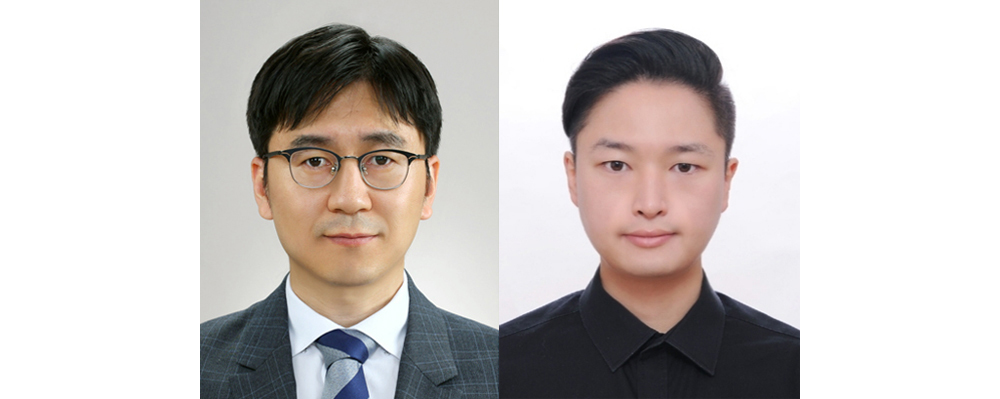커뮤니티
부경투데이
- 국립 부경대학교의 다양한 모습과 소식을 접하시면 부경대학교가 한번 더 가까워집니다.
| 영국 왕립화학회 국제학술지에 실렸다(Paper on journal of the RSC) | |||
| 작성자 | 대외협력과 | 작성일 | 2023-02-24 |
| 조회수 | 471 | ||
| 영국 왕립화학회 국제학술지에 실렸다(Paper on journal of the RSC) | |||||
 |
대외협력과 |  |
2023-02-24 |  |
471 |
부경대 정성철 교수팀, 전고체전지 이온확산 메커니즘 규명
- 상용화 수준 이온전도도 확인 … 영국 왕립화학회 국제학술지 게재

△정성철 교수(왼쪽)와 전태곤 학생.
국립부경대학교는 정성철 교수(물리학과) 연구팀이 전고체전지의 핵심 요소인 고체전해질의 이온확산 메커니즘을 규명하는 데 성공했다고 밝혔다.
현재 휴대용 전자기기, 전기자동차 등에 사용되는 리튬이온전지는 가연성이 있는 액체전해질을 사용해 발화나 폭발의 위험성이 있다.
전고체전지는 액체전해질 대신 비가연성의 고체전해질을 사용해 전지의 안전성과 에너지 밀도를 현저히 개선할 수 있어 차세대 배터리로 주목받고 있지만, 고체전해질의 이온전도도는 아직 액체전해질의 수준(1 mS/cm 이상)에 미치지 못해 상용화에 어려움을 겪고 있다.
정 교수와 전태곤 석박사통합과정생은 산화안정성과 이온전도도가 높아 최근 주목을 받는 할라이드계 고체전해질 ‘Li3Y(Br3Cl3)’의 리튬이온 확산과정을 제일원리 분자동역학 시뮬레이션(first-principles molecular dynamics simulation) 연구를 통해 원자 수준에서 규명해냈다.
정 교수팀은 열역학적으로 가장 안정한 Li3Y(Br3Cl3) 구조의 이온전도도가 22.3 mS/cm까지 이를 수 있음을 제시했다. 이때 리튬이온의 확산이 단일 이온이 아닌 두 이온이 동시에 움직이는 협력적인 공동확산(concerted diffusion)을 통해 진행된다는 것도 확인했다.
정 교수는 “공동확산 메커니즘은 지금까지 많은 고체전해질 물질에서의 리튬 확산방식으로 알려진 결함확산(vacancy diffusion)과는 다른 방식으로, 향후 연구에서 공동확산 또한 리튬의 확산 메커니즘 중 하나로 고려돼야 한다는 것을 시사한다.”라고 밝혔다.
연구팀은 또 Li3Y(Br3Cl3)의 전도도가 다른 할라이드계 고체전해질인 Li3YCl6와 Li3YBr6의 전도도에 비해서 1.4~7.4 배 더 높다는 결과를 확인하고, 할로겐 음이온들의 적절한 혼합을 통해 더욱 향상된 이온전도도를 갖는 할라이드계 고체전해질을 계발할 수 있다는 결과를 제시했다.
정 교수 연구팀이 과학기술정보통신부(중견연구)의 지원을 받아 수행한 이번 연구는 영국 왕립화학회(Royal Society of Chemistry)가 발간하는 화학·물리·재료 분야의 권위 있는 국제학술지 <Journal of Materials Chemistry A>(IF=14.511)에 지난 2월 1일 온라인판으로 게재됐다. <부경투데이>
A research team led by Prof. Jung Sung-Chul at PKNU identified the mechanism of ion diffusion in solid-state batteries
- ion conduction at a commercially available level confirmed... published in the international journal of the Royal society of chemistry
According to Pukyong National University, professor Jung Sung-Chul (dept. of physics) and his research team succeeded in identifying the mechanism of ion diffusion in solid electrolytes, a key element of solid-state batteries.
Lithium-ion batteries currently used in portable electronic devices and electric vehicles use a flammable liquid electrolyte, which may cause ignition or explosion.
Solid-state batteries are attracting attention as next-generation batteries because they use non-flammable solid electrolytes instead of liquid electrolytes to significantly improve the safety and energy density of batteries. However, the ion conductivity of the solid electrolytes are still not up to the level of the liquid electrolytes (more than 1 mS/cm), making it difficult to commercialize the product.
Professor Jung and a combined master’s and doctoral student Jeon Tae-Gon identified the lithium-ion diffusion process of 'Li3Y(Br3Cl3)', a halide solid electrolyte that has recently attracted attention due to its high stability against oxidation and high ionic conductivity, at the atomic level through first-principles molecular dynamics simulation.
The research team of professor Jung suggested that the ionic conductivity of the most thermodynamically stable Li3Y (Br3Cl3) structure can reach up to 22.3 mS/cm. It was also confirmed that at this conductivity, the diffusion of lithium ions proceeds through concerted diffusion, in which two ions move simultaneously, rather than a single ion.
Professor Jung said, “The concerted diffusion mechanism is completely different from vacancy diffusion, which is known as the diffusion method of lithium in many solid electrolyte materials until now, suggesting that we should also consider concerted diffusion as one of the diffusion mechanisms of lithium in future studies.”
The research team also confirmed that the conductivity of Li3Y (Br3Cl3) is 1.4 to 7.4 times higher than that of other halide solid electrolytes, Li3YCl6 and Li3YBr6, accordingly, they suggested that a halide solid electrolyte with more improved ionic conductivity could be developed through appropriate mixing of halide anions.
The research, conducted by professor Jung’s research team with support from the Ministry of science and ICT (mid-level research), was published online on February 1st in an authoritative international journal <Journal of Materials Chemistry A>(IF=14.511) in the field of chemistry, physics, and materials published by the Royal society of chemistry. <Pukyong Today>